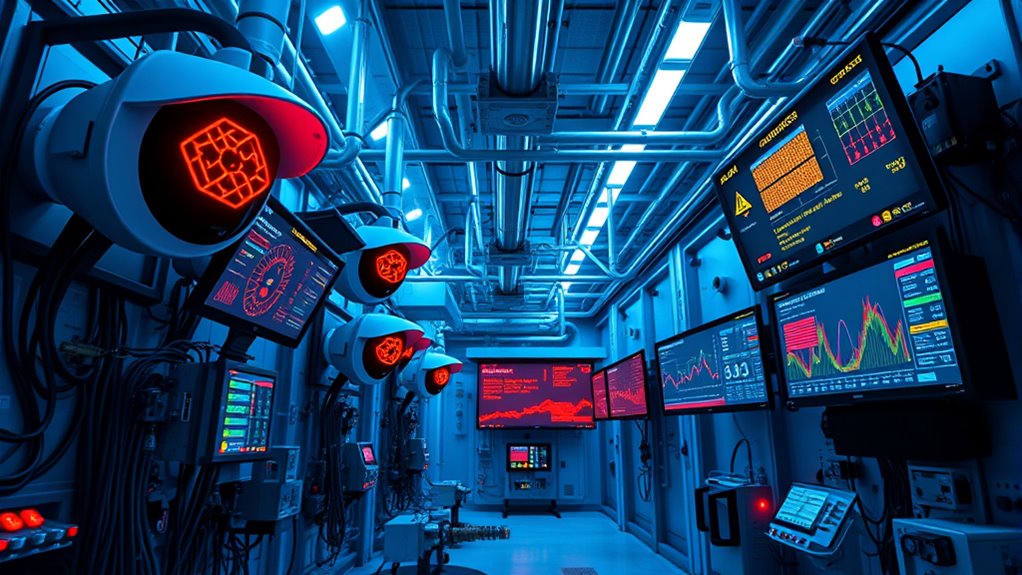AI combined with advanced sensors helps you detect hazards in real time by quickly analyzing diverse data sources like cameras, lidar, and environmental sensors. This technology enables faster, more accurate responses to dangers such as fires or structural issues. Continuous calibration and data fusion improve reliability and reduce false alarms. Staying ahead in safety means constantly refining these systems. If you keep exploring, you’ll discover how these tools can transform hazard prevention and management effectively.
Key Takeaways
- AI analyzes sensor data in real time to identify hazards quickly and accurately.
- Sensor calibration ensures reliable data for effective hazard detection and reduces false alarms.
- Multi-source data fusion combines inputs from cameras, lidar, and environmental sensors for comprehensive situational awareness.
- Continuous monitoring and adaptive algorithms maintain system accuracy amid environmental changes and sensor drift.
- Ongoing cybersecurity measures protect sensor networks and AI systems from cyber threats, ensuring detection integrity.

Advancements in AI and sensor technology are revolutionizing how we detect hazards in real time, enabling faster and more accurate responses to potential dangers. When it comes to sensor systems, proper sensor calibration is essential. You need to guarantee your sensors provide precise and reliable data; otherwise, false alarms or missed threats could occur. Calibration involves adjusting sensor outputs so they align with known standards or reference measurements, which helps eliminate inaccuracies caused by environmental factors or sensor drift over time. Regular calibration maintains the integrity of your hazard detection system, so you can trust that the data your sensors collect truly reflects the real-world conditions.
Proper sensor calibration ensures reliable data and accurate hazard detection.
Additionally, research indicates that ongoing monitoring and AI security measures are crucial to identify and mitigate vulnerabilities within sensor networks, ensuring system resilience against potential cyber threats. Equally important is the concept of data fusion. Instead of relying on a single sensor type, you combine data from multiple sources—such as cameras, lidar, radar, and environmental sensors—to create a complete picture of the situation. Data fusion allows you to cross-verify information, reducing the chances of false positives and negatives. It enhances the system’s robustness by integrating diverse data streams into a unified, coherent understanding of potential hazards. For instance, if a smoke detector detects smoke, but infrared sensors don’t confirm heat or movement, the system can better determine whether there’s a real fire or a false alarm. This layered approach improves response times and accuracy, critical for protecting lives and property.
Implementing sensor calibration and data fusion isn’t a one-time task; it requires ongoing attention. You should regularly recalibrate sensors to account for environmental changes, wear and tear, or sensor aging. This ensures your hazard detection system remains sensitive and accurate over time. Meanwhile, refining data fusion algorithms allows your system to adapt and improve its decision-making capabilities. Machine learning models can be trained to weigh sensor inputs based on their reliability at any given moment, making your hazard detection smarter and more resilient. As you integrate these technologies, you’ll notice that your system becomes more adept at identifying true threats swiftly, minimizing false alarms and ensuring rapid responses.
Ultimately, the combination of precise sensor calibration and sophisticated data fusion elevates your hazard detection capabilities. It turns raw sensor data into actionable intelligence, enabling real-time responses that can save lives and prevent damage. By continuously fine-tuning these processes, you keep your system at the cutting edge of safety technology. As AI advances, you’ll find that these integrated approaches become even more effective, providing you with reliable, timely insights into hazards, no matter how complex or dynamic the environment. This proactive stance ensures you stay ahead of potential dangers, leveraging the full power of modern sensor and AI innovations.
Frequently Asked Questions
What Are the Main Limitations of Current Hazard Detection Sensors?
You’ll find that current hazard detection sensors often face limitations like the need for regular sensor calibration to maintain accuracy. They can also generate false alarms, which lead to unnecessary disruptions and reduce trust in the system. Additionally, environmental factors such as dust, moisture, or extreme temperatures can impair sensor performance, making it harder to reliably detect hazards in real-time. These issues highlight the need for ongoing improvements in sensor technology.
How Does AI Improve Sensor Data Accuracy?
AI acts like a skilled conductor, harmonizing data from multiple sensors through sensor fusion to improve accuracy. It analyzes patterns with predictive analytics, catching subtle changes that might go unnoticed. This process filters out noise and enhances data reliability, making your hazard detection system more precise. As a result, you get clearer, more trustworthy insights, helping you respond faster and safer in real-time situations.
What Industries Benefit Most From Real-Time Hazard Detection?
You benefit most from real-time hazard detection in industries like manufacturing, construction, and environmental monitoring. These sectors rely on instant alerts to prevent accidents, protect workers, and ensure compliance with safety standards. By using advanced sensors and AI, you get immediate insights into potential risks such as gas leaks, fires, or structural issues. This enhances industrial safety and helps you respond swiftly, minimizing damage and safeguarding lives and the environment.
Are There Privacy Concerns With Sensor Data Collection?
You should know that privacy concerns do exist with sensor data collection. Data privacy is vital to protect personal information, and sensor security ensures that data isn’t accessed or tampered with by unauthorized parties. When implementing real-time hazard detection, it’s imperative to use secure sensors and follow privacy regulations. This way, you can balance safety benefits with respecting individual privacy, preventing misuse or breaches of sensitive data.
How Cost-Effective Are Ai-Powered Hazard Detection Systems?
AI-powered hazard detection systems are like a well-oiled machine, offering significant cost reductions by automating risk monitoring. You’ll find their scalability options make expanding coverage easier and more affordable, turning complex safety needs into manageable tasks. While initial investments might seem steep, the long-term savings from preventing accidents and reducing manual inspections make these systems highly cost-effective. You get proactive safety without breaking the bank.
Conclusion
As you harness AI and sensors, you become a vigilant guardian, transforming chaos into clarity. Like a lighthouse cutting through stormy seas, these technologies illuminate dangers before they strike, guiding you safely through uncertainty. Remember, in this digital age, you’re wielding a powerful compass—one that detects hazards in real time, turning potential storms into calm waters. Embrace this synergy, and navigate the future with confidence, knowing you’re shaping a safer world, one alert at a time.









